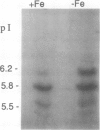Abstract
Reduction of Fe3+ to Fe2+ is a prerequisite for Fe uptake by tomato roots. Ferric chelate reductase activity in plasma membranes (PM) isolated from roots of both iron-sufficient (+Fe) and iron-deficient (−Fe) tomatoes (Lycopersicon esculentum Mill.) was measured as NADH-dependent ferric citrate reductase and exhibited simple Michaelis-Menten kinetics for the substrates, NADH and Fe3+(citrate3−)2. NADH and Fe3+(citrate3−)2 Km values for reductase in PM from +Fe and −Fe tomato roots were similar, whereas Vmax values were two- to threefold higher for reductase from −Fe tomatoes. The pH optimum for Fe-chelate reductase was 6.5. Fe-chelate reductases from −Fe and +Fe tomato roots were equally sensitive to several triazine dyes. Reductase was solubilized with n-octyl β-d-glucopyranoside and electrophoresed in nondenaturing isoelectric focusing gels. Three bands, with isoelectric points of 5.5 to 6.2, were resolved by enzyme activity staining of electrofocused PM proteins isolated from +Fe and −Fe tomato roots. Activity staining was particularly enhanced in the isoelectric point 5.5 and 6.2 bands solubilized from −Fe PM. We conclude that PM from roots of +Fe and −Fe plants contain Fe-chelate reductases with similar characteristics. The response to iron deficiency stress likely involves increased expression of constitutive Fe-chelate reductase isoforms in expanding epidermal root PM.
Full text
PDF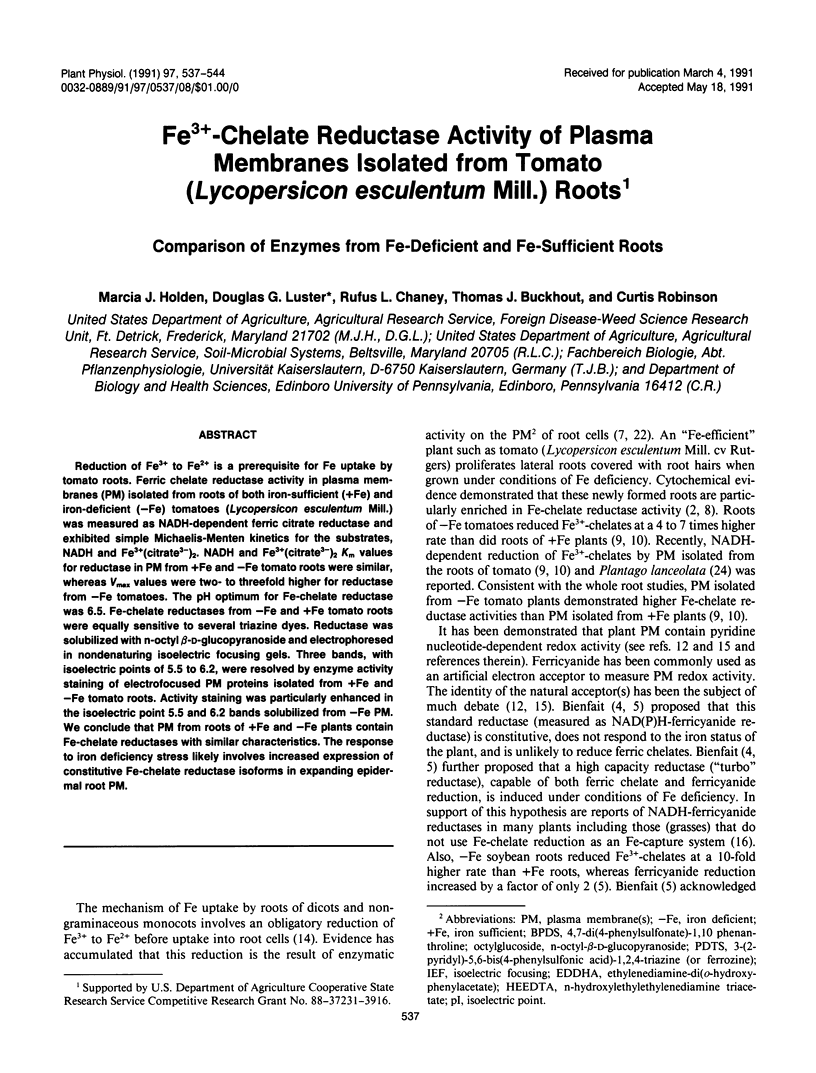
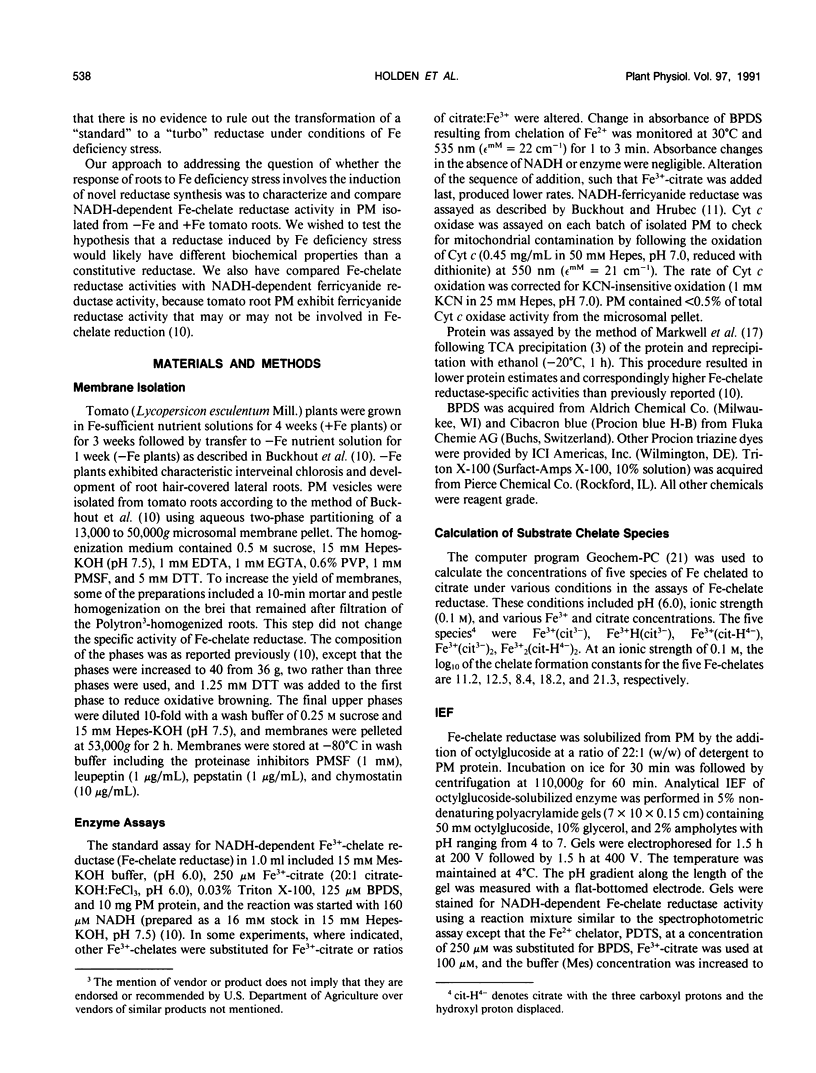


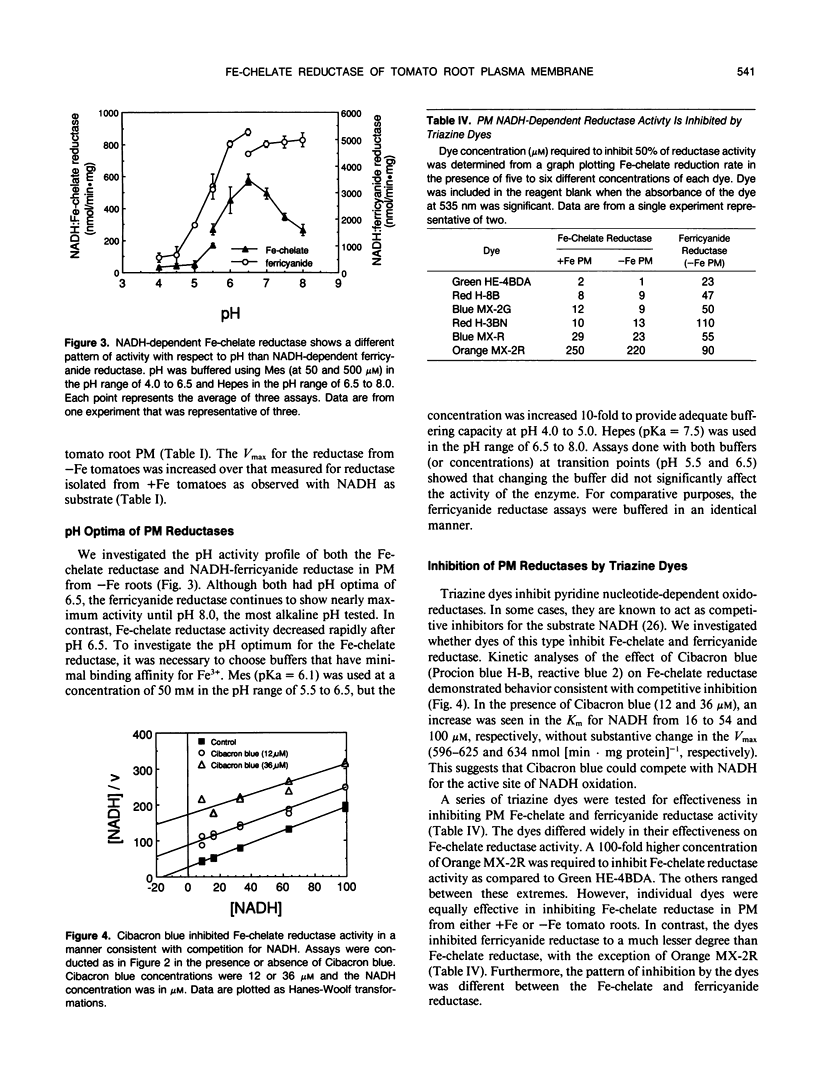
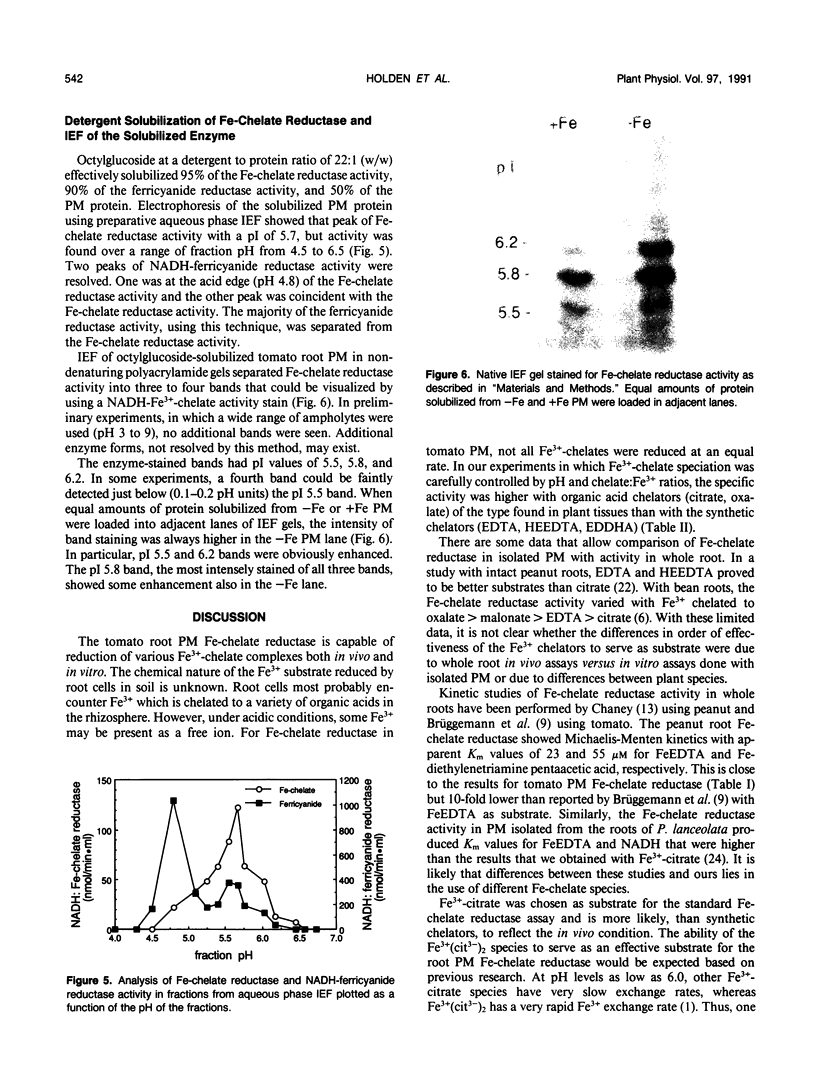
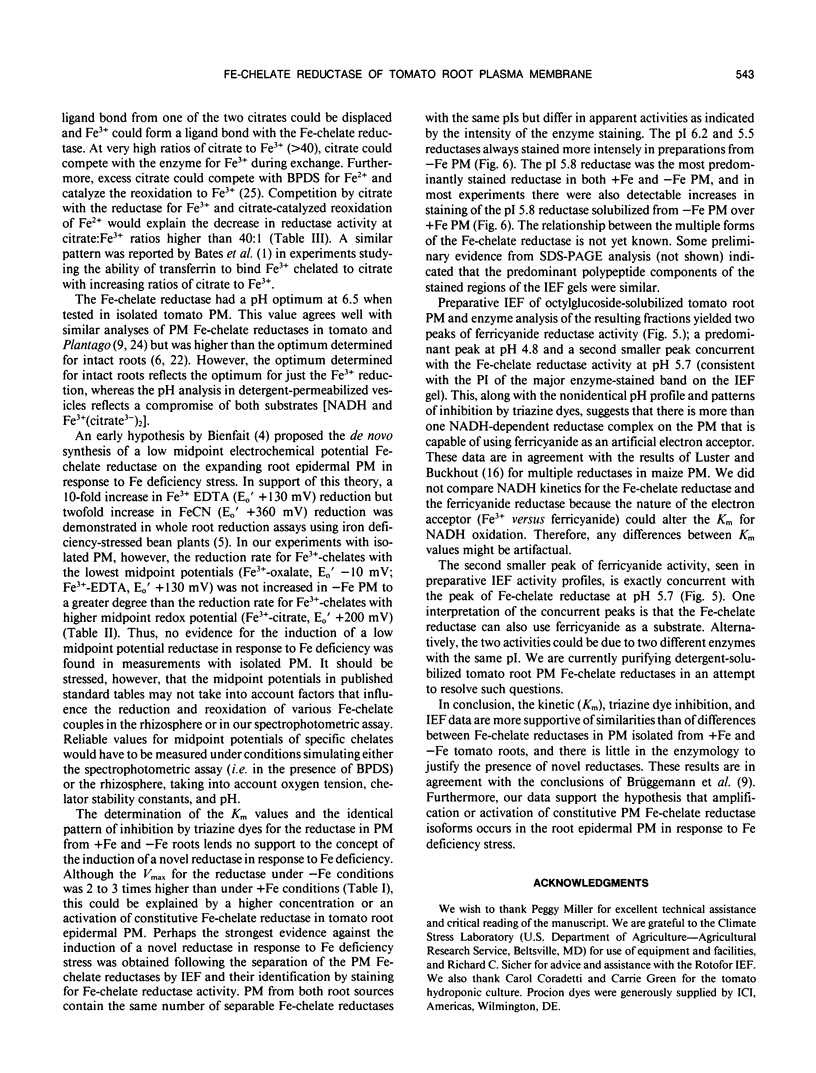
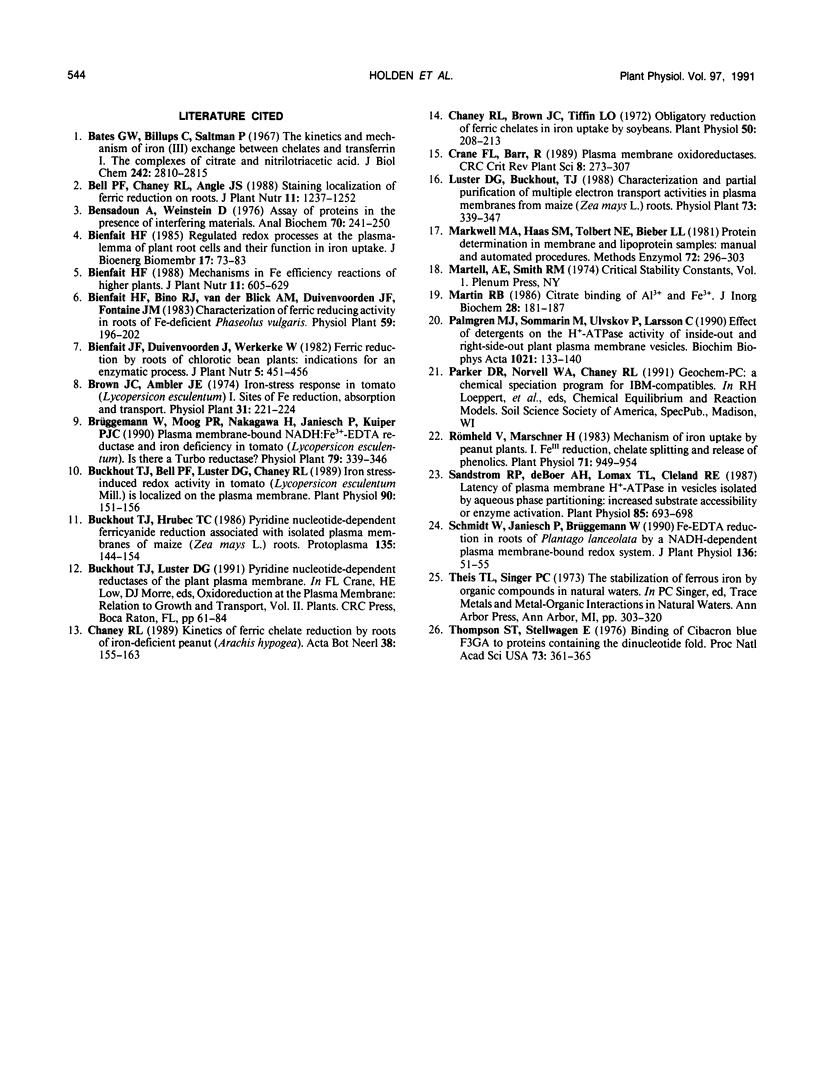
Images in this article
Selected References
These references are in PubMed. This may not be the complete list of references from this article.
- Bates G. W., Billups C., Saltman P. The kinetics and mechanism of iron (3) exchange between chelates and transferrin. I. The complexes of citrate and nitrilotriacetic acid. J Biol Chem. 1967 Jun 25;242(12):2810–2815. [PubMed] [Google Scholar]
- Bensadoun A., Weinstein D. Assay of proteins in the presence of interfering materials. Anal Biochem. 1976 Jan;70(1):241–250. doi: 10.1016/s0003-2697(76)80064-4. [DOI] [PubMed] [Google Scholar]
- Bienfait H. F. Regulated redox processes at the plasmalemma of plant root cells and their function in iron uptake. J Bioenerg Biomembr. 1985 Apr;17(2):73–83. doi: 10.1007/BF00744199. [DOI] [PubMed] [Google Scholar]
- Buckhout T. J., Bell P. F., Luster D. G., Chaney R. L. Iron-Stress Induced Redox Activity in Tomato (Lycopersicum esculentum Mill.) Is Localized on the Plasma Membrane. Plant Physiol. 1989 May;90(1):151–156. doi: 10.1104/pp.90.1.151. [DOI] [PMC free article] [PubMed] [Google Scholar]
- Chaney R. L., Brown J. C., Tiffin L. O. Obligatory reduction of ferric chelates in iron uptake by soybeans. Plant Physiol. 1972 Aug;50(2):208–213. doi: 10.1104/pp.50.2.208. [DOI] [PMC free article] [PubMed] [Google Scholar]
- Markwell M. A., Haas S. M., Tolbert N. E., Bieber L. L. Protein determination in membrane and lipoprotein samples: manual and automated procedures. Methods Enzymol. 1981;72:296–303. doi: 10.1016/s0076-6879(81)72018-4. [DOI] [PubMed] [Google Scholar]
- Martin R. B. Citrate binding of Al3+ and Fe3+. J Inorg Biochem. 1986 Oct-Nov;28(2-3):181–187. doi: 10.1016/0162-0134(86)80081-2. [DOI] [PubMed] [Google Scholar]
- Palmgren M. G., Sommarin M., Ulvskov P., Larsson C. Effect of detergents on the H(+)-ATPase activity of inside-out and right-side-out plant plasma membrane vesicles. Biochim Biophys Acta. 1990 Jan 29;1021(2):133–140. doi: 10.1016/0005-2736(90)90025-j. [DOI] [PubMed] [Google Scholar]
- Römheld V., Marschner H. Mechanism of iron uptake by peanut plants : I. Fe reduction, chelate splitting, and release of phenolics. Plant Physiol. 1983 Apr;71(4):949–954. doi: 10.1104/pp.71.4.949. [DOI] [PMC free article] [PubMed] [Google Scholar]
- Sandstrom R. P., Deboer A. H., Lomax T. L., Cleland R. E. Latency of Plasma Membrane H-ATPase in Vesicles Isolated by Aqueous Phase Partitioning : Increased substrate Accessibility or Enzyme Activation. Plant Physiol. 1987 Nov;85(3):693–698. doi: 10.1104/pp.85.3.693. [DOI] [PMC free article] [PubMed] [Google Scholar]
- Thompson S. T., Stellwagen E. Binding of Cibacron blue F3GA to proteins containing the dinucleotide fold. Proc Natl Acad Sci U S A. 1976 Feb;73(2):361–365. doi: 10.1073/pnas.73.2.361. [DOI] [PMC free article] [PubMed] [Google Scholar]



